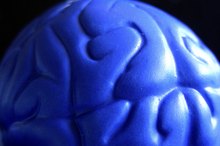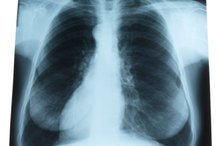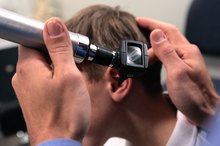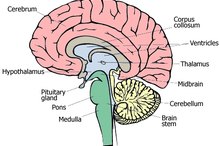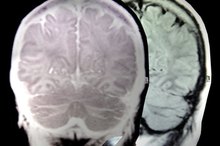Parts of the Brain That Control Primitive Reflexes
The brain is a complex network of structures that work in harmony to control the many vital functions of the body and process information from the internal and outside environment. The vast majority of these functions are reflex actions that occur automatically and in harmony with other parts of the brain and the body.
The Brain Stem
The brain stem is located below the brain at the back of the neck and contains the vital control center of the body called the medulla oblongata. This area is a major part of the brain that is responsible for multiple automatic and involuntary functions that are necessary for life. These vital functions include the beating of the heart, respiration or breathing, blood pressure, digestion, and swallowing. The brain stem is also responsible for alertness, or the state of being conscious, and arousal.
- The brain stem is located below the brain at the back of the neck and contains the vital control center of the body called the medulla oblongata.
The Cerebellum
Four Main Parts of the Brain
Learn More
The National Institute of Neurological Disorders and Stroke describes the cerebellum as the center of control for reflex actions, balance and coordinating muscle movement. It is also part of the brain stem and governs automatic movement, as well as synchronized movement of skeletal muscles.
The Hypothalamus
The hypothalamus is an important organ in the brain that is only about the size of a pearl. It helps to control several major functions including homeostasis of the body. The hypothalamus also directs the release of the hormone adrenaline in times of stress, fear, excitement, or anger. Additionally, it is an emotional center that causes feelings of anger, sadness, joy and exhilaration.
- The hypothalamus is an important organ in the brain that is only about the size of a pearl.
The Amygdala
What Do the Parts of the Brain Control?
Learn More
The amygdala is a small lobe inside the brain that is part of the limbic system. The Alzheimer’s Disease Research website notes that this area of the brain has many functions including developing, associating and remembering reflexive emotions such as fear and anxiety. In primitive states, this function is an important part of survival and is still used as a protective method by the body.
Cinguate Gyrus
The cinguate gyrus is a large arch-like lobe in the center of the inner brain that is a part of the limbic system. This area of the brain functions to process conscious emotional experience.
Parietal Lobe
The parietal lobe is one of the four major lobes of the brain and is located at the back and top of the head. According to the Newark University Hospital, the brain cells in this lobe help to maintain homeostasis of the body by regulating and processing temperature, touch and movement. The parietal lobe is also involved in taste and other body functions.
Related Articles
References
- Center for Neuroskills: Brain Functions and Map
- Alzheimer’s Disease Research: Anatomy of the Brain
- Boly M, Massimini M, Tsuchiya N, Postle BR, Koch C, Tononi G. Are the Neural Correlates of Consciousness in the Front or in the Back of the Cerebral Cortex? Clinical and Neuroimaging Evidence. J Neurosci. 2017;37(40):9603-9613.
- Jawabri KH.Physiology, Cerebral Cortex Functions.StatPearls [Internet]. Treasure Island (FL): StatPearls Publishing; 2019-. Accessed June 22, 2019
- Hurley RA, Flashman LA, Chow TW, Taber KH. The brainstem: anatomy, assessment, and clinical syndromes. J Neuropsychiatry Clin Neurosci. 2010;22(1):iv, 1-7. doi: 10.1176/jnp.2010.22.1.iv
- Wagner MJ, Kim TH, Savall J, Schnitzer MJ, Luo L. Cerebellar granule cells encode the expectation of reward. Nature. 2017;544(7648):96-100. doi: 10.1038/nature21726
- Fama R, Sullivan EV. Thalamic structures and associated cognitive functions: Relations with age and aging. Neurosci Biobehav Rev. 2015;54:29-37. doi: 10.1016/j.neubiorev.2015.03.008
- Biran J, Tahor M, Wircer E, Levkowitz G. Role of developmental factors in hypothalamic function. Front Neuroanat. 2015;9:47. doi: 10.3389/fnana.2015.00047
- Anand KS, Dhikav V. Hippocampus in health and disease: An overview. Ann Indian Acad Neurol. 2012;15(4):239-46. doi: 10.4103/0972-2327.104323
- Lanciego JL, Luquin N, Obeso JA. Functional neuroanatomy of the basal ganglia. Cold Spring Harb Perspect Med. 2012;2(12):a009621. doi: 10.1101/cshperspect.a009621
- Carter, R. The Human Brain Book. New York: Penguin; 2014.
- Kalat, JW. Biological Psychology. Boston, MA: Cengage Learning; 2016.
Writer Bio
Noreen Kassem is a hospital doctor and a medical writer. Her articles have been featured in "Women's Health," "Nutrition News," "Check Up" and "Alive Magazine." Kassem also covers travel, books, fitness, nutrition, cooking and green living.
